
Updated by Jay Brant on January 22, 2025
Headsets provide hands-free communications with professional audio quality. They can connect to your desktop phone, smartphone, computer, and more. Noise cancelling headsets block out distractions and provide crystal-clear audio, much better than a phone or computer provides. Office headsets come with productivity enhancing features like integrated call controls and on-call indicators.
Shopping for headsets can be confusing: platform compatibility, device connectivity, wearing styles, and so on. In this detailed Headsets Buyer’s Guide, we go through all you need to know about headsets, so you’ll know that you are buying the right headset for your needs.
Table of Contents
- What is an office headset?
- What’s the difference between office headsets and gaming headsets?
- The First Question: Compatibility
- What’s the difference between stereo headsets and mono headsets?
- What types of wireless headsets are there?
- What types of wired headsets are there?
- What headset features should I pay attention to?
- Active Noise Cancellation (ANC)
- Passive Noise Cancellation
- Noise Cancelling Microphone
- Hearing Protection Technology
- On-Call Indicator
- Integrated Call Controls
- High-Fidelity Audio
- Audio Pass-Through
- When would I want to use a headset?
- Open Office Headsets
- Video Conferencing Headsets
- Microsoft Teams Headsets
- VoIP Phone Headsets
- Call Center Headsets
- Home Office Headsets
- Mobile Worker Headsets
- What are the different headset wearing styles?
- Headband, Over-the-Head Headsets
- Earbuds, In-Ear Headsets
- Earhook, Over-the-Ear Headsets
- Neckband, Behind-the-Head Headsets
- Convertible Headsets
- Headset Management Applications
- What are the benefits of an office headset?
What is an office headset?
A headset is a headphone with a microphone. It combines the private listening experience of headphones with improved voice reproduction and noise reduction. It lets you hear conversations or media better. And it keeps your hands free as you work.
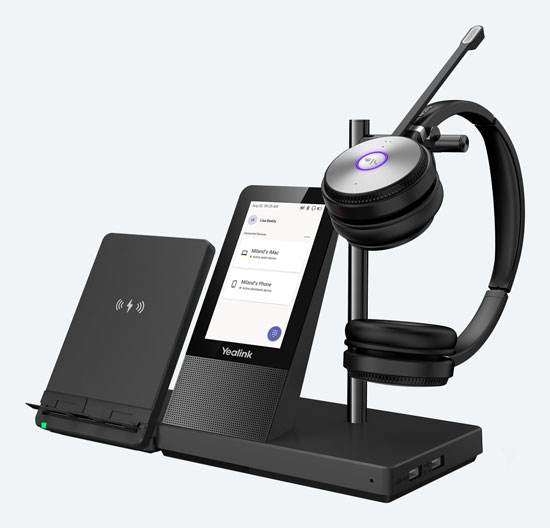
Yealink WH66 Teams is a wireless DECT headset with a base station that offers multiple device connectivity and an integrated USB hub. It’s pictured here with the optional Yealink WHC60 Qi Wireless Charger.
Office headsets improve productivity and the work experience. They connect to a variety of business devices, like VoIP phones or laptops. They give you the option between mono and stereo sound and come in a variety of wearing styles. VoIP headsets integrate seamlessly with business communications platforms like Microsoft Teams. We get into all this stuff — and much more — in this guide.
We specify “office headsets” to differentiate what we’re talking about from gaming headsets or music headphones. Office headsets might be called “business headsets,” “VoIP phone headsets,” “VoIP headsets,” “headsets for VoIP,” or many other names. You might see the terms “call center headsets” or “contact center headsets” — these are office headsets with features specific to those environments.
Most of the time, however, they’re just called headsets. So that’s what we use in this buyer’s guide. We cover headsets from the leading headset manufacturers, including:
A quick note: You can absolutely use your office headset for music, too. In fact, more and more headset manufacturers are emphasizing sound quality for media. If you want the best sound quality for music or movies, look for a headset with high-fidelity audio. We discuss hi-fi audio quality in detail below.
What’s the difference between office headsets and gaming headsets?
Office and gaming headsets are essentially the same thing: headphones with a microphone. However, besides looking different, they emphasize features specific to their intended use-cases.
Gaming headsets emphasize low latency, which means that there’s less of a gap between what you hear and what you see on your display. Low latency lets you react quicker and more accurately. Those microseconds are vitally important when gaming, but they’re nothing to worry about when using a headset for business applications.
Many gaming headsets now support spatial, positional, or 3D audio (different terms for the same feature) which means you can hear sounds above you, behind you, in front of you, and so on. This feature helps when you need to dodge the zombie that’s about to bite you from behind, but you don’t need to worry about zombies when video conferencing (we hope), so it’s not a feature that has any real value for business meetings.
All this said, many people use an office headset for gaming and vice versa, and they’re very happy doing so.
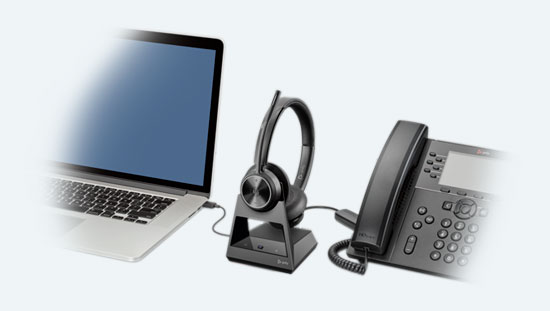
Poly Savi 7320 Office offers simultaneous multiple device connectivity through its base station. This powerful wireless DECT headset offers military-grade privacy features.
The First Question: Compatibility
Here’s the first question you need to ask when shopping for an office headset:
Is this headset compatible with my device(s) and service(s)?
For device compatibility, you want to make sure that the headset interfaces with the devices you want to work on: VoIP phone, smartphone, tablet, laptop, and so on. Do you need a USB dongle for Bluetooth connectivity? Does the DECT headset’s base station connect to multiple devices? What QD cable do you need for the RJ9 headset? If you’d like to know about using your headset with your smartphone, check out our blog, “Office Headsets for Hybrid Workers to Use with Smartphones.”
For service compatibility, you want to triple check that the headset is compatible with the communications platform you use for work: VoIP phone system, cloud phone service, softphone, video conferencing platform, unified communications platform, and so on. Some services, like Microsoft Teams, have certification programs that guarantee compatibility; others dont’t. We cover Microsoft Teams Certified headsets in detail below.

Yealink BH70 Mono UC is a versatile Bluetooth headset with better than all-day battery life and a custom monaural speaker for professional audio quality.
USB and Bluetooth headsets can be used with basically every service, because USB and Bluetooth are ubiquitous open standards. You can select the headset as an audio peripheral on your device. However, while it’ll work, it might not support every possible feature: check feature compatibility before you buy.
Many VoIP headset manufacturers provide updated compatibility guides. Jabra, Poly (Plantronics), and Yealink are three of the most popular headset for VoIP manufacturers. Here are links to their headset compatibility guides (external links):
- Jabra Headsets Compatibility Guide
- Poly (Plantronics) Headsets Compatibility Guide
- Yealink Headsets Compatibility Guide
For more information about VoIP phone systems and cloud phone services, check out our clear, detailed VoIP Phone Systems Buyer’s Guide.
What’s the difference between stereo headsets and mono headsets?
Headsets come in either stereo (binaural, two-ear) or mono (monaural, one-ear). Stereo headsets have two earphones while mono headsets have one. Which you prefer is a personal choice, but there are advantages to both styles.
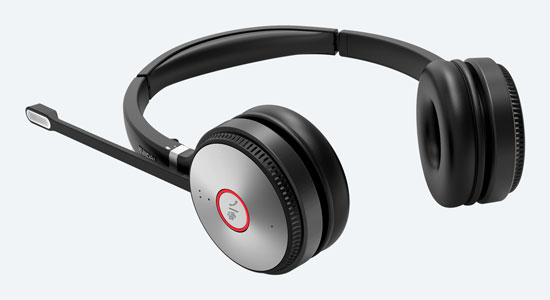
This model of Yealink WH62 Teams gives you exceptional stereo Super Wideband audio quality and Acoustic Shield noise reduction.
What are the advantages of stereo headsets?
Stereo headsets have two earphones, which sit over, on, or in both your ears. Why would you choose a stereo headset?
- Noise cancellation. Because both your ears are covered by earphones, stereo headsets naturally offer better noise cancellation than mono headsets. If you want active noise cancellation (ANC), the headset will always be a stereo headset. We cover active noise cancellation below. Noise cancellation is one of the most desired features by workers today. It’s vital for workers in open-plan offices and for hybrid or remote workers who work in more casual environments or on-the-go.
- Improve focus. Because they block out more noise, stereo headsets can help you focus on your work better.
- Audio quality. Stereo headsets typically offer better audio quality than mono headsets: two is better than one. But manufacturers might also design stereo headsets for music and media in mind on top of business communications. Look for a headset with dynamic equalization (EQ), which adapts the audio quality for different applications. If you’d like to know more, check out our blog, “What Is Dynamic Equalization for Headsets?”
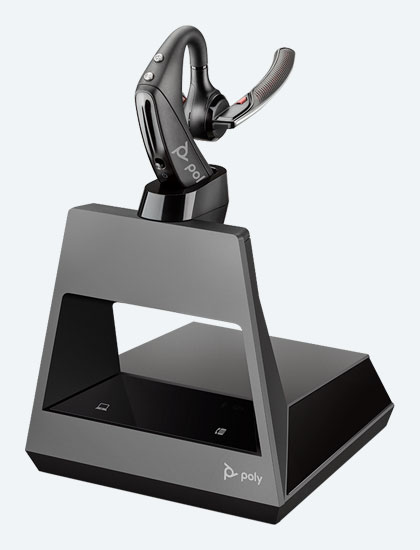
Poly Voyager 5200 Office is an ultra-lightweight Bluetooth headset with WindSmart technology and an adaptive digital signal processor (DSP) for exceptional audio quality.
What are the advantages of mono headsets?
Mono headsets have one earphone, which sits on or in either of your ears. Why would you choose a mono headset?
- Hear your environment. The primary advantage of a mono headset is that your free ear can hear what’s happening around you as you work, which can be really useful in the office.
- Hear yourself. Many people like having a free ear to let them hear how loud they’re talking. We’ve all had experiences with people talking too loudly when they’re listening to their headphones. A mono headset lets you hear yourself.
- Price. Mono headsets are typically less expensive than the equivalent stereo model in a given headset series. If, for example, you’re outfitting a call center, this can add up to real savings.
What types of wireless headsets are there?
Wireless Headsets or Cordless Headsets provide professional audio with the convenience of having no wires, so you can wander with your headset on and you never have to worry about the cable catching on anything.
There are two types of wireless office headsets:
There are two features specific to wireless headsets that you should think about no matter which type you go with:
- Wireless range. Wireless range (or wander range) refers to how far you can be away from the device you’re connected to while still having a stable connection. Manufacturers tend to list maximum possible range, so keep in mind that obstacles like walls significantly reduce wireless range.
- Talk time. Talk time refers to how long the battery can last when used for communications. Make sure the headset can cover how long you’ll use it on a busy day. If you’re using it one the road, you might look for a headset carrying case that doubles as a charging case.
Are there Wi-Fi office headsets?
Some gaming headsets come with Wi-Fi connectivity. To the best of our knowledge, no major office headset manufacturer currently produces a Wi-Fi office headset, so the answer is, for now, no.

Yealink BH76 UC is a versatile Bluetooth headset with Qualcomm aptX improved audio, Qi wireless charging support, and much more.
Bluetooth Headsets
Bluetooth Headsets use the popular Bluetooth wireless protocol to connect to your devices.
Why use a Bluetooth headset? The biggest advantages are compatibility and versatility. Because Bluetooth is so widely supported, the headset will be compatible with a huge range of devices out of the box. This means you can likely use the same headset with your VoIP phone, smartphone, tablet, laptop, and more. Some Bluetooth headsets connect to more than one device at the same time, making them even more convenient. Because of their versatility, hybrid workers who work in multiple locations are particularly appreciative of Bluetooth headsets.
To use a Bluetooth headset with a VoIP phone, the phone must support Bluetooth. The phone might support Bluetooth natively or it might require a Bluetooth adapter, which will plug into one of the phone’s USB ports. Having a USB port, however, doesn’t mean the phone supports a Bluetooth dongle; check the phone’s user manual.
To use a Bluetooth headset with a computer, you’ll need a Bluetooth adapter that plugs into one of the computer’s USB ports.
Many Bluetooth headsets come with a USB dongle in the package. These dongles are also available separately. There are USB-A and USB-C variants to work with whichever port type(s) your device has. Make sure you’re buying the correct one.
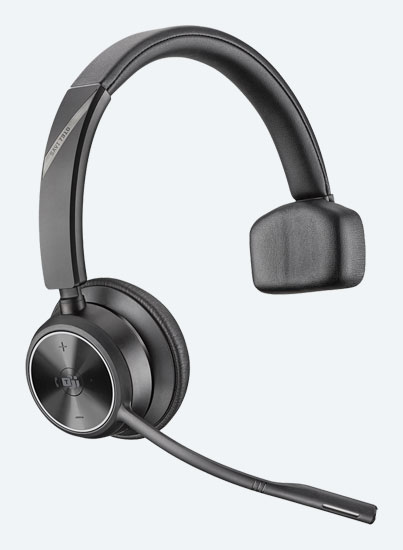
Poly Savi 7310 Office takes full advantage of the potential of DECT with military-grade encryption, nearly 600-foot wireless range and 2x device density compared with other DECT headsets.
DECT Headsets
DECT Headsets use the DECT protocol for wireless communications. DECT is a well-established protocol that offers several advantages over Bluetooth:
- Reduce spectrum density. Today, there are an enormous number of wireless devices in the office. Most of these devices use Bluetooth and/or Wi-Fi. DECT uses a separate section of the wireless spectrum from those two, which means DECT headsets don’t interfere with Bluetooth or Wi-Fi devices. The result is better connectivity for everyone.
- Extended wireless range. DECT offers a wireless range beyond what Bluetooth can offer. Some DECT headsets have wireless ranges of 600 feet line of sight — two football fields! Even in offices with walls, cubicles, and so on, DECT headsets provide the best wireless range for office headsets available today.
- Excellent security. DECT can provide exceptional communications security with advanced encryption and more. The Poly Savi 7300 Office Series, for example, offers military-grade information security.
DECT base stations, DECT adapters
Unlike Bluetooth headsets, DECT headsets can’t connect directly to your devices. They require either a base station or USB dongle. The headset communicates with the base or dongle. The experience on your end is as seamless as using a Bluetooth headset.
A DECT base station connects via cables to a computer or phone. Some base stations offer multiple device connectivity, which means they connect to a computer and phone at the same time. You can use the headset for calls on both devices, switching between them with the press of a button on the base station.
A DECT dongle, like the one that comes with Yealink WH63 Portable, is a simple plug-and-play affair, just like using a Bluetooth dongle.
What types of wired headsets are there?
Wired Headsets or Corded Headsets connect to a device via a cable. They tend to be less expensive than wireless headsets. Wired connectivity can be more reliable and easier to setup than wireless connectivity, as anyone who’s had trouble with Bluetooth will know. There are three primary types of wired headsets:
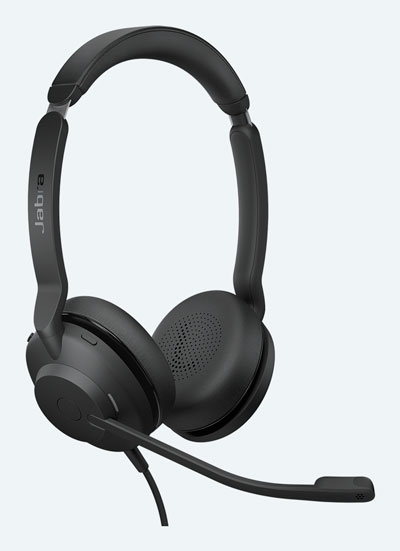
Jabra Evolve2 30 offers plug-and-play USB connectivity. Its advanced digital chipset and noise-isolating microphone array provide first-class audio performance.
USB Headsets
USB Headsets provide plug-and-play connectivity with computers and VoIP phones using either a USB-A or USB-C plug. They’re very easy to use, often have integrated call controls, and work with almost every communications service or system as an audio peripheral.
Many VoIP phones now have a dedicated USB port for a headset. Just because a VoIP phone has a USB port, however, doesn’t mean it supports a USB headset. Manufacturers will specify if the phone supports a USB headset or not. Make sure to check before buying.
They come with either USB-A or USB-C connectivity.
- USB-A is the familiar USB standard with the bigger, rectangular, non-reversible plug.
- USB-C is the newer USB standard with the smaller, pill-shaped, reversible plug.
Make sure you get a headset with the USB plug that fits your devices. Some headsets, like Poly Blackwire 5220, now have USB-C cables with a USB-A adapter attached to the cable. These let you use the headset with either port type out of the box, which is convenient. And Blackwire 5220 even lets you use it with a 3.5 mm jack, too.
Sidenote: a USB-C headset might work with your smartphone or tablet if the phone has a USB-C jack, like most Android phones.
RJ9 Headsets
RJ9 headsets use a traditional telephone style plug. The port on the phone might be called RJ9, 4P4C, RJ10, RJ22 or even just a “modular” jack. RJ9 is the most common label. Almost every VoIP phone has two RJ9 ports: one for the phone’s handset and one for a headset. These wired headsets are comparatively inexpensive and easy to use. They’re only used with desktop phones.
QD (Quick Disconnect), EHS (Electronic Hook Switch)
You might come across the term “QD headsets”. QD (Quick Disconnect) is a cable technology that allows you to disconnect your headset without dropping a call. If you have to ask your manager about something, for example, you won’t need to take off your headset. It’s primarily used with RJ9 headsets, although there are options for USB and 3.5 mm headsets.
Because RJ9 is not a set standard, RJ9 ports are not all wired the same way. This means that that QD cables or adapters are specific to the various manufacturers. Jabra and Poly (Plantronics) headsets, for example, use different QD cables. One of the secondary benefits of QD is that it lets you use the same headset with a different phone. If you need to switch phones, you only need to get the appropriate QD cable, rather than buy a brand-new headset.
You might also come across the term EHS (Electronic Hook Switch). EHS refers to another type of headset adapter that enables call control on the headset instead of requiring you to interact with the phone console. EHS adapters are also specific to the various manufacturers.
Remember: When shopping for QD or EHS cables, make sure to check the manufacturers’ compatibility guides.
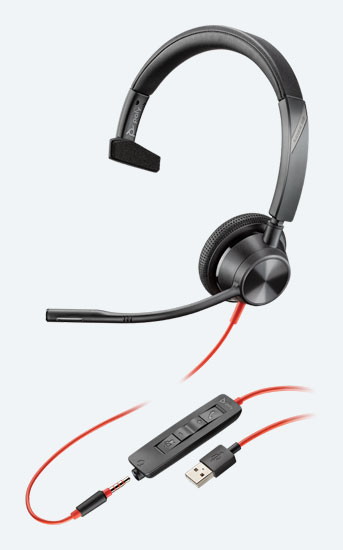
Poly Blackwire 3315 gives you USB-A, USB-C, and 3.5 mm connectivity with in-line call controls at an exceptional price-point.
3.5 mm Headsets
Some headsets also offer plug-and-play 3.5 mm connectivity, which lets you use it with any smartphone, tablet or computer that has a standard 3.5 mm jack.
Typically, 3.5 mm headsets don’t only offer 3.5 mm connectivity. They offer USB and 3.5 mm connectivity. They’ll come with a USB cable that has an in-line call controller. The 3.5 mm plug inserts into this controller, so you can connect via USB. Or you can skip the USB cable and use the 3.5 mm headset directly with a device.
The primary advantages of 3.5 mm headsets are simplicity and compatibility. Plug-and-play, works with anything? Not a bad choice at all.
You might come across 2.5 mm headsets. Same deal as above, just with the smaller plug. Some wireless handsets still have 2.5 mm headset jacks. These are quite rare nowadays.
What headset features should I pay attention to?
Here are some of the most popular features that people look for with headsets:
- Active Noise Cancellation (ANC)
- Passive Noise Cancellation
- Noise Cancelling Microphone
- Hearing Protection Technology
- On-Call Indicator
- Integrated Call Controls
- High-Fidelity Audio
- Audio Pass-Through
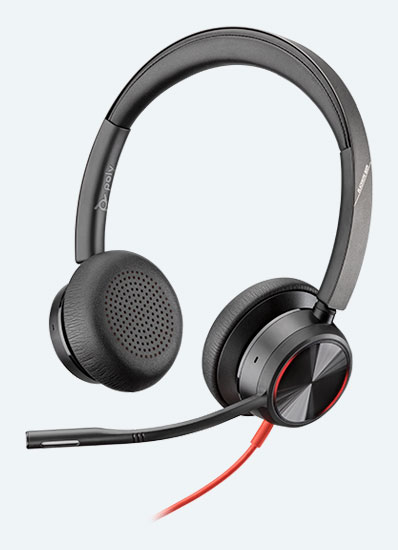
Poly Blackwire 8225 features class-leading Advanced Hybrid Active Noise Cancellation using a 4-microphone array. You can set the level of noise cancellation for how you want to work.
Active Noise Cancellation (ANC)
Active noise cancellation (ANC) means the headset actively filters out ambient and background noise to provide a cleaner listening experience. A headset with ANC uses microphones to sense ambient sound, then produces counter-sound that mask it. Think of it as audio camouflage. This masking effect means you hear less noise.
ANC is especially important for open office workers, because open-plan offices tend to be loud. Home-office workers with pets, children, or partners might find ANC necessary to focus on their work. And, more than anyone else, people on the go love active noise cancellation for airplanes, buses, public spaces, and so on.
Active noise cancellation headsets are by definition stereo headsets. There’s no point in cancelling noise for one ear when the other’s wide open. ANC is a premium feature, but one of the most desired by workers today. It makes a huge difference.
What is passive noise cancellation?
You’ll also see manufacturers use the term passive noise cancellation, which means that noise is cancelled by the design of the headset, rather than by sound-processing like ANC. It refers to one of two things:
- The earcups block noise naturally by covering your ears.
- The microphone on the boom is directional, meaning it only picks up sound in one direction. The microphone points only at your mouth, limiting the amount of ambient noise it picks up.
In both cases, the noise cancellation comes from design, hence “passive” noise cancellation.
When people refer to a “noise cancelling headset,” they almost always mean one with active noise cancellation. However, manufacturers will sometimes call a headset “noise cancelling” if it only offers passive noise cancellation. If you want active noise cancellation, make sure the headset is giving you what you want.
Noise Cancelling Microphone
Active noise cancellation typically refers to what you hear. But what about how you sound? Look for a noise cancelling microphone. We mention in the box above passive noise cancellation via a directional microphone. But headsets can do even more. Take, for example, Poly Acoustic Fence, which sets a virtual perimeter around you, eliminating background noise. It can lead to your voice sounding much better.
Hearing Protection Technology
If you’re on a headset all day long with the volume up for too long, hearing damage can become a real concern. Many headset manufacturers now offer volume-limiting features to protect your hearing. There are two primary types you should be aware of:
- Reduce average exposure. The headset system will take an average of the decibel level over a certain period of time and keep that time-weighted average below a certain threshold. This feature reduces long-term exposure to damaging noise. Usually, the limit’s in the 80 to 85 dBA range. The National Institute for Occupational Safety and Health (NIOSH) recommends a maximum of 85 dBA over an 8-hour workday.
- Limit sudden noises. The headset system automatically cuts off any noise above a certain decibel level, usually around 115 dB. This feature, which is often called “anti-startle” technology, reduces short-term exposure to damaging noise. Australia has a regulation that specifies a 102 dB maximum; if you see “G616” protection, it’s referring to this Australian regulation.
These features have many names. Jabra calls time-weighted average limitation IntelliTone and sudden noise limitation PeakStop. The two together are called SafeTone. Poly calls sudden noise limitation SoundGuard. They don’t have a specific name for time-weighted average limitation. SoundGuard DIGITAL is the two together. Often, you can set the levels of hearing protection in the headset’s management application.
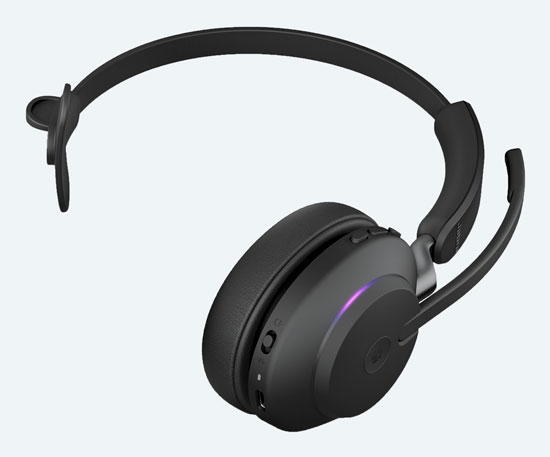
The on-call indicator of Jabra Evolve2 65 Mono, Microsoft Teams Edition, has been designed for 360° visibility. This Bluetooth headset has a 40mm speaker and integrated call controls, including a dedicated Microsoft Teams button.
On-Call Indicator
An on-call indicator is a light built into the headset to indicate the user’s status, that is, whether or not you’re busy. Often called a busy light or busylight, it lets coworkers know at a glance when you need to focus. Many offices find on-call indicators useful for reducing distractions.
If you’d like to know more, check out our blog, “What Is a Headset Busylight? What Are Its Advantages?’
Integrated Call Controls
Many headsets offer in-line call controls or call controls built into the headphones. Typical controls include volume up/down, answer/end call, and mute. Microsoft Teams headsets have a dedicated button for launching the service to answer Teams calls and so on.
Integrated call controls streamline your communications experience. They’re a convenience that many workers appreciate. Note that just because your headset has call controls, however, it doesn’t mean that the controls will work with every platform. Look at the manufacturer’s compatibility charts to make sure.
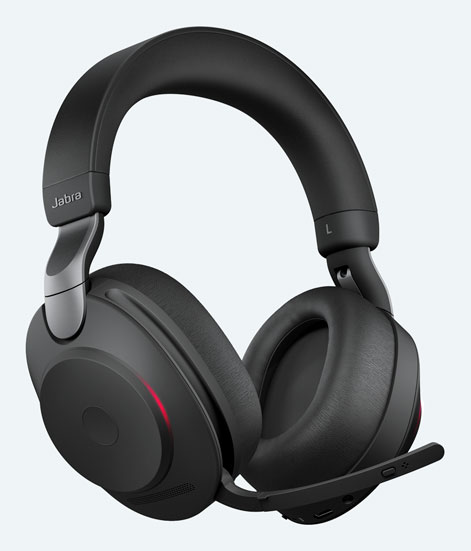
If you want first-class audio, check out Jabra Evolve2 85. The Bluetooth headset uses 10 microphones for premium voice reproduction and active noise cancellation. The over-the-ear stereo speakers offer hi-fi audio quality.
High-Fidelity Audio
Why buy a headset for business and headphones for music when you can have one device for both? That’s the idea behind headsets offering hi-fi audio. The average human can perceive sounds between 20 Hz and 20 kHz on the audio spectrum. Human voices fall along a comparatively narrow band of this spectrum, so, for speech, a headset typically reproduces sound in that band.
We can hear music, however, across this entire spectrum. So hi-fi audio means the headset covers the whole range, giving you exceptional sound quality. The headset will sound as good for speech as it will for music. Some headsets offer a “music mode” or “media mode,” which means it will switch between optimizing sound quality for speech vs music. You may have to manually select hi-fi mode in the headset’s management application.
Audio Pass-Through
What if you want to hear what’s happening around you without taking off your headset? Some headsets offer audio pass-through, sometimes called transparency mode. Essentially, this technology does the opposite of active noise cancellation: it uses microphones to sense sound around you, then broadcasts that sound into your ears. The result is that you hear what’s happening around you without removing your headset. It’s a quality-of-life feature, one that many people like.
If you’d like to know more, check out our blog, “What Is Audio Pass-Through for Headsets?’
When would I want to use a headset?
Headsets are an increasingly popular choice for workers. There are many options with many different features. Here are some common scenarios where people use headsets and what features you should look for:
- Open Office Headsets
- Video Conferencing Headsets
- Microsoft Teams Headsets
- VoIP Phone Headsets
- Call Center Headsets
- Home Office Headsets
- Mobile Worker Headsets

Poly Voyager Focus 2 offers Digital Hybrid Active Noise Cancellation, making a “focus zone” for you to work more effectively.
Open Office Headsets
Open-plan offices are built to improve collaboration. While many workers appreciate the creativity and energy created by the looser atmosphere, there are two possible sources of friction: noise and privacy. If you want an open office headset, look for a stereo headset with good noise cancellation. To increase privacy, get a headset with an on-call indicator to let coworkers know when you need to focus or you’re on a call.
Video Conferencing Headsets
As more and more work is done over video conferencing, voice quality and background noise reduction have become very important. For a video conferencing headset, look for these features. A noise cancelling microphone in particular is highly useful. Integrated call controls make it easy to mute your microphone when you’re not speaking to help reduce noise.
Make sure your headset is compatible with your video conferencing service. USB headsets are compatible with pretty much every service, as are 3.5 mm headsets, but you’ll want to double check anyways.
Want to know more about video conferencing? We go deep in our Video Conferencing Buyer’s Guide.
Microsoft Teams Headsets
Microsoft Teams Certified Headsets are automatically identified by the service, making them plug-and-play. They will have a Microsoft Teams button that lets you launch the service with one click. Some Microsoft Teams headsets meet the Open Office requirements for noise cancellation, which is one of the highest noise cancellation standards you can find.
For more on Microsoft Teams headsets, check out our blog, “Headsets That Work with Microsoft Teams.”
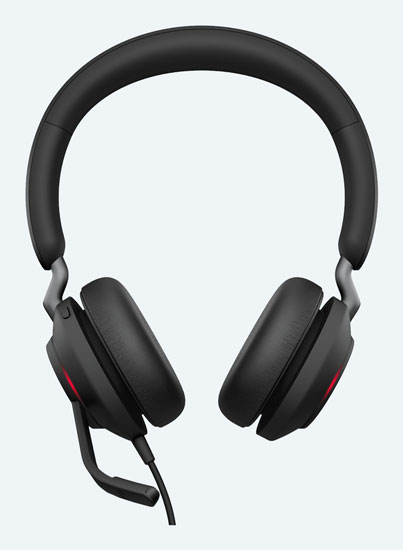
Jabra Evolve2 40 offers plug-and-play USB connectivity with integrated call controls and an on-call indicator. The 3-microphone array provides first-class sound isolation to improve voice quality.
VoIP Phone Headsets
VoIP phone headsets keep your hands free while you’re on a call. Many headsets support call control, so you can, for example, answer a call by just tapping a button on your headset.
You can use wired or wireless headsets with VoIP phones. Most phones have a dedicated RJ9 headset port in the back. Many now have USB ports that support USB headsets. If the phone has a USB port, you’ll want to make sure that port supports a USB headset, as not all of them do. Many phones support Bluetooth, either natively or by using a USB dongle. DECT headsets connect to a phone through their base stations. The base connects to the VoIP phone.
For an in-depth look at VoIP phones, check out our VoIP Phones Buyer’s Guide.
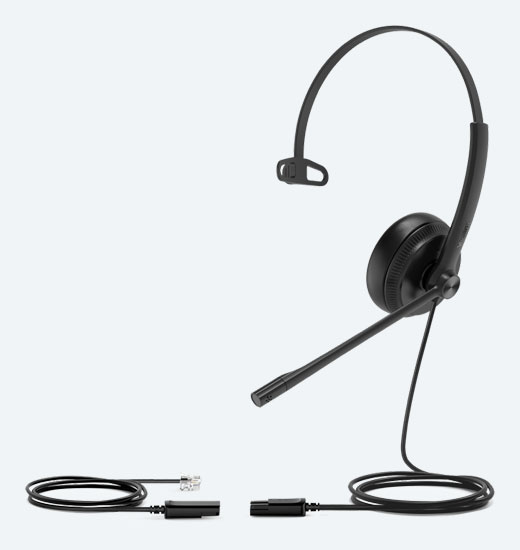
Yealink YHS34 Mono is a cost-effective wired headset with QD connector. AcousticProtection technology reduces long-term hearing damange.
Call Center Headsets
Call centers require lots of headsets that are durable enough and comfortable enough for all-day use without breaking the bank. Simplicity is essential to reduce learning time and user error. Call center headsets are typically wired headsets for cost-savings. They should be lightweight, feature ear protection technology and versatile. Call controls on the headset or the headset’s cable can streamline the call agent’s workflow. On-call indicators let workers know when someone is a on a call, another convenient feature to look for.
Home Office Headsets
Headsets are excellent options for communications in your home office. If you have a noisy household with children, pets or partners, active noise cancellation (ANC) can be a big plus. USB headsets are simple to use and work with almost every softphone and unified communications platform. And let’s be honest: at home, you can listen to your music and podcasts all day long, if that’s the kind of worker you are. So go ahead, emphasize audio quality with your home office headset.
Mobile Worker Headsets
Mobile workers have specific needs that many headsets don’t need. Bluetooth headsets are convenient, because you don’t have to worry about wires catching on anything and you can use it just fine with your smartphone. Active noise cancellation (ANC) is highly prized, although many people prefer an ultra-lightweight and discreet earhook Bluetooth headset so you can always be connected. If you use your mobile worker headset outside often, look for weather resistance, so if you get caught in a rainstorm, your headset won’t be ruined.
What are the different headset wearing styles?
Headsets come in a number of different form-factors. Which one you go with is entirely a matter of personal opinion, although some do have certain advantages.

Yealink WH64 Hybrid Dual Teams is a wireless headset that offers dual Bluetooth and DECT connectivity using Yealink’s Hybrid Core technology.
- Headband, Over-the-Head Headsets
- Earbuds, In-Ear Headsets
- Earhook, Over-the-Ear Headsets
- Neckband, Behind-the-Head Headsets
- Convertible Headsets
Headband, Over-the-Head Headsets
The headband is by far the most common form factor. And why not? They’re secure and allow you to have larger earcups and a longer microphone boom for better audio quality. Because of the larger earcups, you can have call controls on the headset itself.
Earbuds, In-Ear Headsets
Earbuds sit in your ears. They’re ultra-lightweight and convenient. They might not, however, have as good listening or microphone sound quality as other varieties, because of their size.
If you’re looking for AirPod-like earbuds that don’t have a cable between them, look for “true wireless earbuds.” It’s a bit clumsy, but that’s what the industry has settled on for now.
Earhook, Over-the-Ear Headsets
Earhooks fit over your ear, like the classic businessman Bluetooth headset. Earhook headsets are ultra-lightweight, monaural and, often, extremely portable.
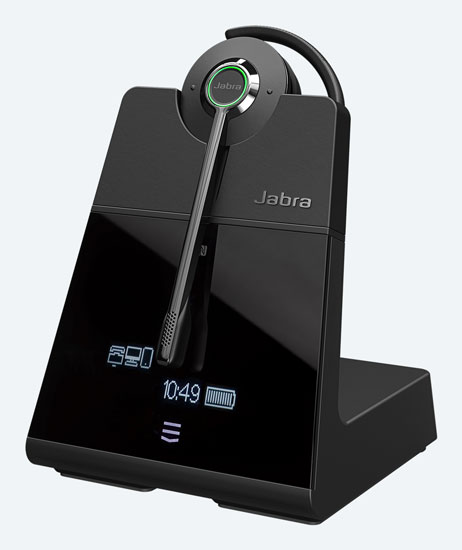
Jabra Engage 75 Convertible is an elite wireless DECT headset that lets you choose between earhook, headband and neckband wearing styles.
Neckband, Behind-the-Head Headsets
There are a few headsets that come with a neckband, which means that the earphones are connected behind your head. Some people like neckbands because they don’t mess with your hair. If you have a large hairstyle, a neckband might be for you.
Convertible Headsets
When you see the term “convertible headset,” it means that the headset comes with a variety of wearing styles that you can select from and change between. A typical selection includes headband, earhook and neckband.
If you’d like to know more, check out our blog, “What Is a Convertible Headset?”
Headset Management Applications
Many headset manufacturers offer free applications for managing headsets on your computer. These apps let you customize features, update firmware and more. Here are links to the manufacturers’ websites to download their applications (external links):
What are the benefits of an office headset?
Here are 6 important reasons why headsets are so popular in offices today:
- Hands-free communications. Headsets keep your hands free when you’re on a call: no need to awkwardly pinch the phone between your head and shoulder.
- Improved voice reproduction. Compared with a computer, laptop, smartphone or tablet, a headset provides better voice reproduction. This means your voice will sound fuller and more natural to the person you’re talking to. Improved voice reproduction has been shown to increase comprehension. It also presents you in a more positive light to your customers or clients, because you sound better.
- Private audio. Most of us, when we’re working, aren’t by ourselves. In an office, on the road, in a café or at home, there’s almost always someone around. If everyone just broadcasted their calls publicly, it would be chaotic, not to mention that everyone would hear your conversation. Headsets give you privacy and reduce noise.
- Mobile convenience. Rather than being tied to the desktop phone, a wireless headset lets you wander around while being ready for a call. And features like in-line or on-headset call controls make it even easier.
- Portability. It’s much easier to carry around a USB or Bluetooth headset for business-class communications with your laptop or smartphone than it is to setup a desktop phone.
- Versatility. On top of its business applications, you can use a headset for music and media, too. If you fly a lot, you can get a headset with active noise cancellation.
If you have any questions or for additional help, please contact us at 888.201.9056 or email us at service@ipphone-warehouse.com.
© 2025 IP Phone Warehouse. All rights reserved, including the right to reproduce this Headsets Buyer’s Guide or portions thereof in any form whatsoever.
